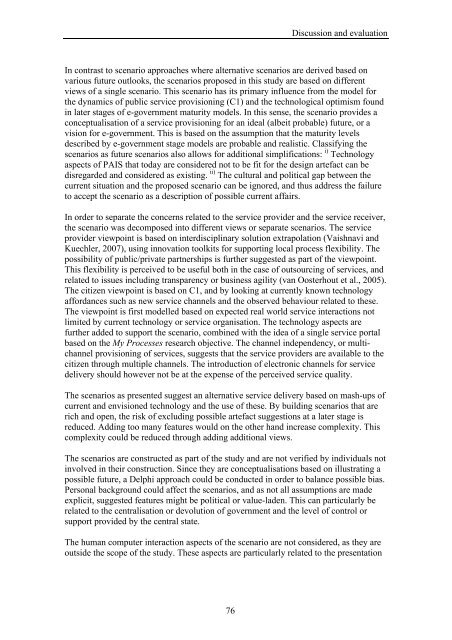Multi-channel provisioning of public services - Department of ...
Multi-channel provisioning of public services - Department of ...
Multi-channel provisioning of public services - Department of ...
You also want an ePaper? Increase the reach of your titles
YUMPU automatically turns print PDFs into web optimized ePapers that Google loves.
Discussion and evaluation<br />
In contrast to scenario approaches where alternative scenarios are derived based on<br />
various future outlooks, the scenarios proposed in this study are based on different<br />
views <strong>of</strong> a single scenario. This scenario has its primary influence from the model for<br />
the dynamics <strong>of</strong> <strong>public</strong> service <strong>provisioning</strong> (C1) and the technological optimism found<br />
in later stages <strong>of</strong> e-government maturity models. In this sense, the scenario provides a<br />
conceptualisation <strong>of</strong> a service <strong>provisioning</strong> for an ideal (albeit probable) future, or a<br />
vision for e-government. This is based on the assumption that the maturity levels<br />
described by e-government stage models are probable and realistic. Classifying the<br />
scenarios as future scenarios also allows for additional simplifications: i) Technology<br />
aspects <strong>of</strong> PAIS that today are considered not to be fit for the design artefact can be<br />
disregarded and considered as existing. ii) The cultural and political gap between the<br />
current situation and the proposed scenario can be ignored, and thus address the failure<br />
to accept the scenario as a description <strong>of</strong> possible current affairs.<br />
In order to separate the concerns related to the service provider and the service receiver,<br />
the scenario was decomposed into different views or separate scenarios. The service<br />
provider viewpoint is based on interdisciplinary solution extrapolation (Vaishnavi and<br />
Kuechler, 2007), using innovation toolkits for supporting local process flexibility. The<br />
possibility <strong>of</strong> <strong>public</strong>/private partnerships is further suggested as part <strong>of</strong> the viewpoint.<br />
This flexibility is perceived to be useful both in the case <strong>of</strong> outsourcing <strong>of</strong> <strong>services</strong>, and<br />
related to issues including transparency or business agility (van Oosterhout et al., 2005).<br />
The citizen viewpoint is based on C1, and by looking at currently known technology<br />
affordances such as new service <strong>channel</strong>s and the observed behaviour related to these.<br />
The viewpoint is first modelled based on expected real world service interactions not<br />
limited by current technology or service organisation. The technology aspects are<br />
further added to support the scenario, combined with the idea <strong>of</strong> a single service portal<br />
based on the My Processes research objective. The <strong>channel</strong> independency, or multi<strong>channel</strong><br />
<strong>provisioning</strong> <strong>of</strong> <strong>services</strong>, suggests that the service providers are available to the<br />
citizen through multiple <strong>channel</strong>s. The introduction <strong>of</strong> electronic <strong>channel</strong>s for service<br />
delivery should however not be at the expense <strong>of</strong> the perceived service quality.<br />
The scenarios as presented suggest an alternative service delivery based on mash-ups <strong>of</strong><br />
current and envisioned technology and the use <strong>of</strong> these. By building scenarios that are<br />
rich and open, the risk <strong>of</strong> excluding possible artefact suggestions at a later stage is<br />
reduced. Adding too many features would on the other hand increase complexity. This<br />
complexity could be reduced through adding additional views.<br />
The scenarios are constructed as part <strong>of</strong> the study and are not verified by individuals not<br />
involved in their construction. Since they are conceptualisations based on illustrating a<br />
possible future, a Delphi approach could be conducted in order to balance possible bias.<br />
Personal background could affect the scenarios, and as not all assumptions are made<br />
explicit, suggested features might be political or value-laden. This can particularly be<br />
related to the centralisation or devolution <strong>of</strong> government and the level <strong>of</strong> control or<br />
support provided by the central state.<br />
The human computer interaction aspects <strong>of</strong> the scenario are not considered, as they are<br />
outside the scope <strong>of</strong> the study. These aspects are particularly related to the presentation<br />
76
















